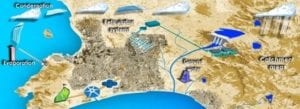The City of Cape Town’s Water and Sanitation Department has launched a new and improved website, loaded with useful information that may assist residents, learners, students, educators and visitors.
The City believes that the use of interactive diagrams, video clips, posters and brochures to present information in a more user-friendly way will significantly improve the experience of those visiting the Water and Sanitation Department’s new website, making it easier to access information and to interpret it. Apart from providing residents and businesses with relevant consumer information about tariffs and billing, visitors to the website can also access departmental contact details and the Consumer Service Charter, setting out the department’s service standards pledge to consumers and consumers’ responsibilities. The website has a strong educational focus aimed at increasing awareness about water and sanitation issues as well as demystifying the department in a way that allows residents and consumers to find out more about water and sanitation services beyond the tap or drain. “Residents can learn about where their water comes from or what happens to their wastewater, providing them the opportunity to see how involved our operations are and also what it takes to enable the City of Cape Town to render good quality services to them.“It also aims to encourage our consumers to participate in the programmes and initiatives that are rolled out in their areas and across the city,” explains Sonnenberg.
Learners and educators in particular, will benefit from the new interactive diagram: the Cape Town water cycle. This webpage provides information on all components of the Cape Town urban water cycle, including all water and sanitation services provided by the City. “The website also provides insight into the many projects that the department is working on, such as the construction of new reservoirs and pipelines, planning for the city’s future water needs, and important projects to protect the sewer system from industrial pollution and the infiltration of rainwater,” concludes Sonnenberg.







